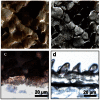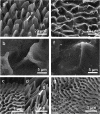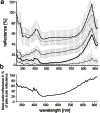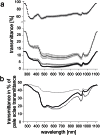Snake velvet black: hierarchical micro- and nanostructure enhances dark colouration in Bitis rhinoceros
- PMID: 23677278
- PMCID: PMC3655483
- DOI: 10.1038/srep01846
Snake velvet black: hierarchical micro- and nanostructure enhances dark colouration in Bitis rhinoceros
Abstract
The West African Gaboon viper (Bitis rhinoceros) is a master of camouflage due to its colouration pattern. Its skin is geometrically patterned and features black spots that purport an exceptional spatial depth due to their velvety surface texture. Our study shades light on micromorphology, optical characteristics and principles behind such a velvet black appearance. We revealed a unique hierarchical pattern of leaf-like microstructures striated with nanoridges on the snake scales that coincides with the distribution of black colouration. Velvet black sites demonstrate four times lower reflectance and higher absorbance than other scales in the UV-near IR spectral range. The combination of surface structures impeding reflectance and absorbing dark pigments, deposited in the skin material, provides reflecting less than 11% of the light reflected by a polytetrafluoroethylene diffuse reflectance standard in any direction. A view-angle independent black structural colour in snakes is reported here for the first time.
Figures







References
-
- Hill G. E. Female house finches prefer colourful males: sexual selection for a condition-dependent trait. Anim. Behav. 40, 563–572 (1990).
-
- Hill G. E. Female mate choice for ornamental coloration. In Bird Coloration: Vol. 2, Function and evolution (Harvard University Press, Chambridge, 2006).
-
- Milinski M. & Bakker T. C. M. Female sticklebacks use male coloration in mate choice and hence avoid parasitized males. Nature 344, 330–333 (1990).
-
- Watkins G. G. Inter-sexual signalling and the functions of female coloration in the tropidurid lizard Microlophus occipitalis. Anim. Behav. 53, 843–852 (1997).
-
- Parker A. R., Mckenzie D. R. & Ahyong S. T. A unique form of light reflector and the evolution of signalling in Ovilipes (Crustacea: Decapoda: Portunidae). Proc R Soc Lond B 265, 861–867 (1998).
Publication types
MeSH terms
LinkOut - more resources
Full Text Sources
Other Literature Sources

